This translation is not official. It is based on the translation of user Fledermaushaus at BoardgameGeek.
Contents
1 board: One-Eye's pirate table
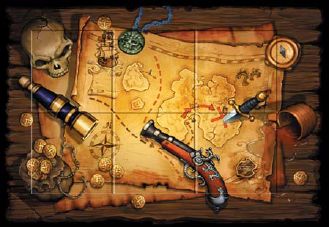 |
8 ship cards

28 sabre cards


23x 5x |
40 jewels

value 1 value 5 value 10
20x 10x 10x |
51 ducats

25x 15x 11x |

56 island cards in 8 colours |
Idea & Aim
Brave pirates, go forth!
In the middle of the great ocean, lie the 8 islands where One-Eye has hidden his immeasurable treasures.
Ducats, sabres, treasure chests and, of course, valuable jewels, are there to plunder.
And all pirates want one thing only: to have the most!
The players take what the others want and hinder each other whilst salvaging the treasure.
And you'll need plenty of sabres to defeat One-Eye, who keeps his beady eye on his treasure.
Your aim is to gather the jewels which you gain from island cards showing jewels or treasure chests.
These cards can be bought or forcibly raided from One-Eye.
The winner is the player with the most jewels at the end of the game.
Preparation
Place the board in the middle of the table.
Each player is given 2 sabres, 1 jewel (of value 1) and 20 ducats.
The remaining sabres, jewels and ducats form a supply to be used during the game.
Depending upon the number of players, some of the island cards are removed and will not be used:
- 2 players: remove all the cards of any 3 colours
- 3 players: remove all the cards of any 2 colours
- 4 players: remove all the cards of any 1 colour
- With 5 players you use all the cards.
Put the removed cards back in the box.
Shuffle the remaining cards and place them as a face-down deck next to One-Eye's table.
Turn over 6 island cards and lay them out face-up, forming the 'display', next to One-Eye's table.
Turn over 1 island card and place it face-up on one of the 6 spaces on One-Eye's table.
Put the 8 ship cards at the bottom of the face-down island card deck.

deck |
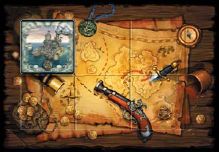
One-Eye's pirate table |
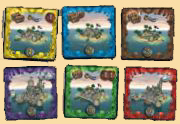
display |
Island Cards
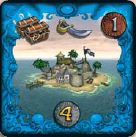 |
Each of the 8 islands has its own colour.
There are 7 different cards for each island, differing in their costs and treasures.
The set of cards for each island is identical.
The bottom edge of each island card shows the cost of the card.
You have to pay this amount of ducats in order to buy the card from the display (in the picture this is 4 ducats).
The top edge shows what the owner of the card will receive after acquiring it (in the picture this is 1 sabre and 1 ducat, as well as having 2 treasure chests for counting up at the end of the game).
Place cards, that you acquire, face-up in front of you on the table.
You then immediately receive any sabres, ducats and jewels. |
Collecting Cards
As you collect cards during the game, arrange them in columns in front of you, with a separate column for each colour.
A new card is placed below any cards of the same colour, overlapping the previous one but ensuring that the treasures on the cards can always be seen.
As soon as a further card of the same colour is added to a column, you immediately receive sabres, ducats and jewels for all the cards in that column!
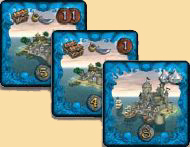 |
Example:
To start with, a player buys a blue island card for 5 ducats (which has 1 chest, 1 sabre and 2 ducats).
He immediately receives 1 sabre and 2 ducats.
On his next turn, he buys the blue island card costing 4 ducats (which has 1 chest, 1 sabre and 1 ducat) and places it overlapping the "5".
He immediately receives 2 sabres and 3 ducats.
Finally he buys the "8" blue island card (which has 2 jewels) and immediately receives 2 sabres, 3 ducats and 2 jewels.
If the player does not acquire any more blue cards, he will have collected 3 treasure chests in this colour for counting up at the end of the game. |
Playing the Game
The youngest player starts, followed by the other players in clockwise order.
On your turn, you carry out the following actions one after the other:
- You must buy an island card from the display.
- You may raid an island card from One-Eye's table.
- You must move an island card from the display onto One-Eye's table
(unless there are already 6 cards on his table).
- You must replenish the display back up to six cards
by turning over one or two new island cards from the deck.
1. Buying an Island Card
You must buy one of the 6 island cards displayed next to One-Eye's pirate table.
Pay the cost shown on the bottom edge of the card by putting that number of ducats back into the supply.
If you do not have enough ducats, you must first obtain them by selling jewels or an island card.
You take 3 ducats from the supply for each jewel; 5 ducats for an island card.
Jewels are put back into the supply; a card that is sold is removed from play.
Place the card you buy face-up along with any other of that colour you have already acquired.
If you do not yet have any cards of that colour, place the card on its own.
You immediately take sabres, money and jewels for all your cards of that colour.
The treasure chests do not take effect until counting up at the end of the game.
Sabres are needed to raid further island cards from One-Eye.
Ducats are needed to buy further island cards from the display.
As many jewels should be collected as possible, so as to have more than the other players at the end of the game.
Arrange your sabres, ducats and jewels in front of you so that they are open to view.
2. Raiding an Island Card from One-Eye (optional)
You may take an island card from One-Eye's table if you put 3 sabres back into the supply.
If the island card which you wish to take has a sabre pictured on it, you must give up 4 sabres for the card.
Place the card face-up on your column of island cards of that colour.
You immediately receive sabres, money and jewels for all your cards of this colour.
3. Moving a Card on to One-Eye's Table
You must take one of the cards from the display and put it on an empty space on One-Eye's table.
You must carry out this action whether or not you took a card from One-Eye.
This action is omitted if there are already 6 island cards on One-Eye's table.
4. Placing new Cards into the Display
Refill the display next to One-Eye's table back up to 6 cards by turning over one or two cards from the deck.
It is then the next player's turn.
End of the Game
The end of the game is in sight as soon as the first ship card is turned over from the deck and placed into the display.
The current round is first played to its end so that all the players have had the same number of turns.
The game is then concluded with a special final round.
The winner is the player with the most jewels after counting up at the end.
Ship Cards
Ship cards are used as island cards of any colour.
When you acquire one, you add it to the column of your choice and take treasures for that column as usual.
However, you cannot have more than 7 cards in a column.
A ship card can also be placed on its own, forming a new column.
Final Round
Put all the cards from the display onto One-Eye's table.
In the final round you can still raid a card from One-Eye for 3 or 4 sabres, adding it to the appropriate column.
Counting up
| Each sabre is exchanged for 3 ducats. |  |
| Ducats are exchanged for jewels at the rate of 5 ducats for 1 jewel. |  |
Treasure Chests
Each colour (island) is evaluated separately.
 |
The player with the most treasure chests of that colour | receives 7 jewels. |
| The player with the second-most | receives 4 jewels. |
| The player with the third-most | receives 1 jewel. |
If there is a tie, all the tied players receive the full amount but the following place is not awarded.
If just one player has chests of a certain colour, he receives 7 jewels.
If a player's cards of a particular colour are all without chests, he cannot receive any jewels for that colour.
Example
Red island colour: Alvilda has 5 chests, Black Beard has 3 and Cartagena Chris has none.
Alvilda receives 7 jewels, Black Beard gets 4 and Cartagena Chris gets none.
Blue island colour: Alvilda and Black Beard both have island cards but neither have any chests.
No one receives any jewels for this island.
Green island colour: Alvilda and Black Beard each have 3 chests, Cartagena Chris has one.
Alvilda and Black Beard both receive 7 jewels and Cartagena Chris gets 1.
The other 5 islands are evaluated in the same way and jewels allocated accordingly.
Variant
An additional way of winning jewels is added.
When counting up, jewels are won for the number of different colours (islands) each player has in his collection of island cards:
| Colours | 3 | 4 | 5 | 6 | 7 | 8 |
| Jewels | 3 | 6 | 10 | 15 | 21 | 28 |
Example
At the end of the game, a player has island cards in 6 different colours.
He receives an additional 15 jewels.